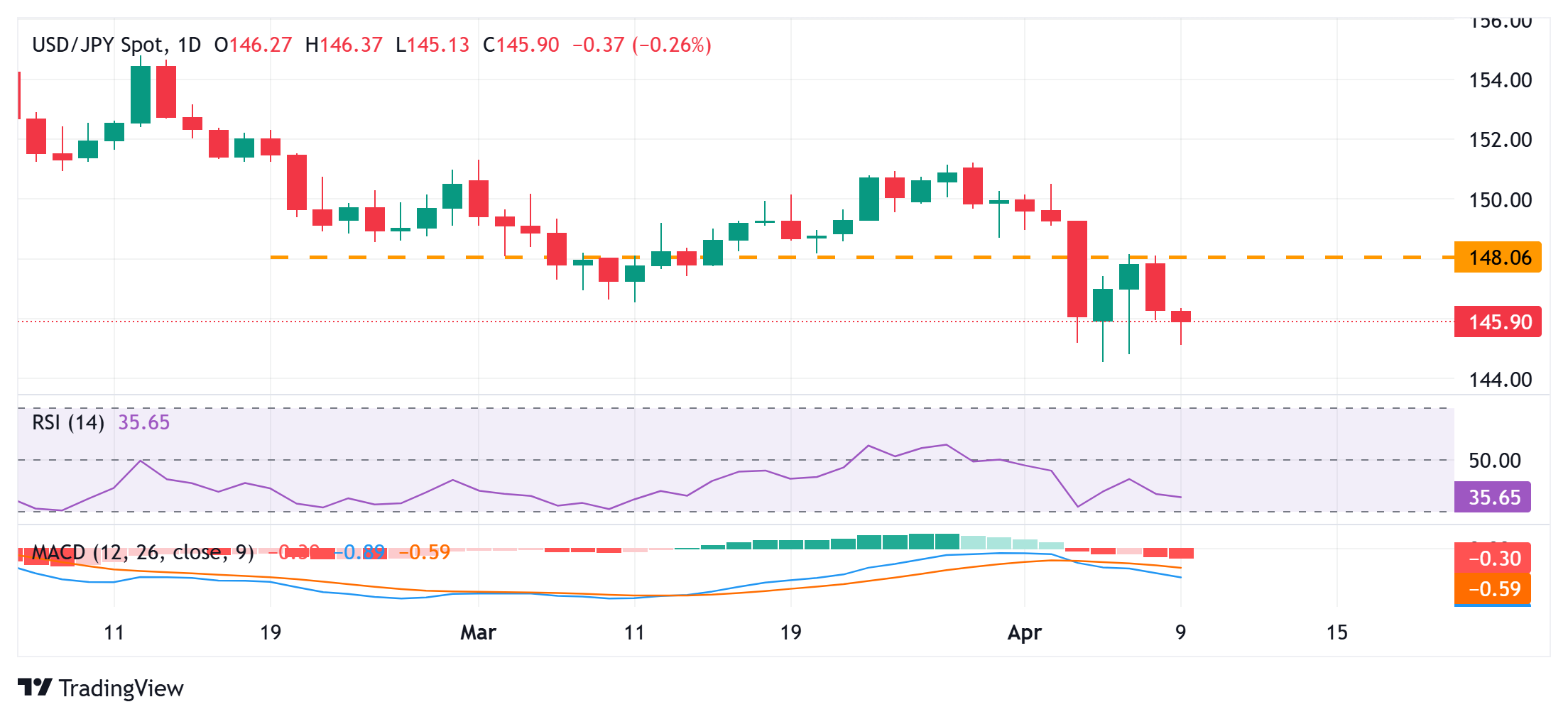Created
: 2025.04.09














![]() 2025.04.09 11:47
2025.04.09 11:47
The Japanese Yen (JPY) buying remains unabated for the second straight day on Wednesday as investors continue to take refuge in the traditional safe-haven currency amid concerns about a tariffs-driven global recession. Moreover, reports that US President Donald Trump has agreed to meet Japanese officials to initiate trade discussions following a phone call with Japan's Prime Minister Shigeru Ishiba fuel optimism about a possible US-Japan trade deal. This, along with expectations that the Bank of Japan (BoJ) will continue raising interest rates on the back of broadening domestic inflation, also underpins the JPY.
Meanwhile, hawkish BoJ expectations mark a big divergence in comparison to rising bets for more aggressive interest rate cuts by the Federal Reserve (Fed). This, in turn, would result in the further narrowing of the rate differential between Japan and the US, which, in turn, is seen as another factor driving flows towards the lower-yielding JPY. Apart from this, the prevalent US Dollar (USD) selling bias drags the USD/JPY pair closer to the 145.00 psychological mark during the Asian session. Traders now look to FOMC meeting minutes for some impetus ahead of US consumer inflation figures on Thursday.

From a technical perspective, this week's failure to find acceptance above the 148.00 mark and the subsequent fall favors bearish traders. Moreover, oscillators on the daily chart are holding deep in negative territory and are still away from being in the oversold zone, suggesting that the path of least resistance for the USD/JPY pair is to the downside. Some follow-through selling below the 145.00 psychological mark will reaffirm the negative outlook and expose the year-to-date low, around the 144.55 region touched on Monday, before spot prices eventually drop to the 144.00 round figure.
On the flip side, the 146.00 mark now seems to keep a lid on any attempted recovery. This is followed by the Asian session high, around the 146.35 region, above which a bout of a short-covering could lift the USD/JPY pair to the 147.00 round figure en route to the 147.40-147.45 area. The subsequent move-up should allow bulls to reclaim the 148.00 mark and test the weekly top, around the 148.15 zone. A sustained strength beyond the latter might shift the near-term bias in favor of bullish traders and pave the way for some meaningful appreciating move.
The Japanese Yen (JPY) is one of the world's most traded currencies. Its value is broadly determined by the performance of the Japanese economy, but more specifically by the Bank of Japan's policy, the differential between Japanese and US bond yields, or risk sentiment among traders, among other factors.
One of the Bank of Japan's mandates is currency control, so its moves are key for the Yen. The BoJ has directly intervened in currency markets sometimes, generally to lower the value of the Yen, although it refrains from doing it often due to political concerns of its main trading partners. The BoJ ultra-loose monetary policy between 2013 and 2024 caused the Yen to depreciate against its main currency peers due to an increasing policy divergence between the Bank of Japan and other main central banks. More recently, the gradually unwinding of this ultra-loose policy has given some support to the Yen.
Over the last decade, the BoJ's stance of sticking to ultra-loose monetary policy has led to a widening policy divergence with other central banks, particularly with the US Federal Reserve. This supported a widening of the differential between the 10-year US and Japanese bonds, which favored the US Dollar against the Japanese Yen. The BoJ decision in 2024 to gradually abandon the ultra-loose policy, coupled with interest-rate cuts in other major central banks, is narrowing this differential.
The Japanese Yen is often seen as a safe-haven investment. This means that in times of market stress, investors are more likely to put their money in the Japanese currency due to its supposed reliability and stability. Turbulent times are likely to strengthen the Yen's value against other currencies seen as more risky to invest in.
![]()
Created
: 2025.04.09
![]()
Last updated
: 2025.04.09

FXStreet is a forex information website, delivering market analysis and news articles 24/7.
It features a number of articles contributed by well-known analysts, in addition to the ones by its editorial team.
Founded in 2000 by Francesc Riverola, a Spanish economist, it has grown to become a world-renowned information website.
We hope you find this article useful. Any comments or suggestions will be greatly appreciated.
We are also looking for writers with extensive experience in forex and crypto to join us.
please contact us at [email protected].
Disclaimer:
All information and content provided on this website is provided for informational purposes only and is not intended to solicit any investment. Although all efforts are made in order to ensure that the information is correct, no guarantee is provided for the accuracy of any content on this website. Any decision made shall be the responsibility of the investor and Myforex does not take any responsibility whatsoever regarding the use of any information provided herein.
The content provided on this website belongs to Myforex and, where stated, the relevant licensors. All rights are reserved by Myforex and the relevant licensors, and no content of this website, whether in full or in part, shall be copied or displayed elsewhere without the explicit written permission of the relevant copyright holder. If you wish to use any part of the content provided on this website, please ensure that you contact Myforex.
Myforex uses cookies to improve the convenience and functionality of this website. This website may include cookies not only by us but also by third parties (advertisers, log analysts, etc.) for the purpose of tracking the activities of users. Cookie policy